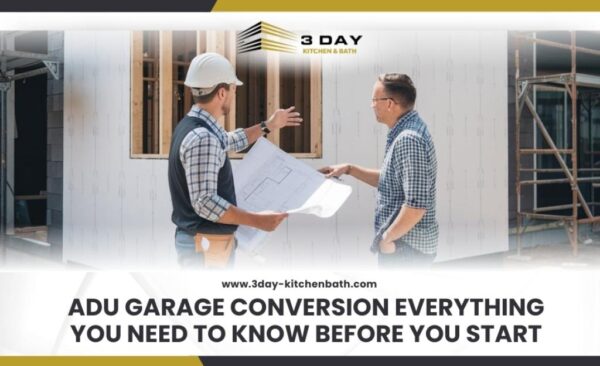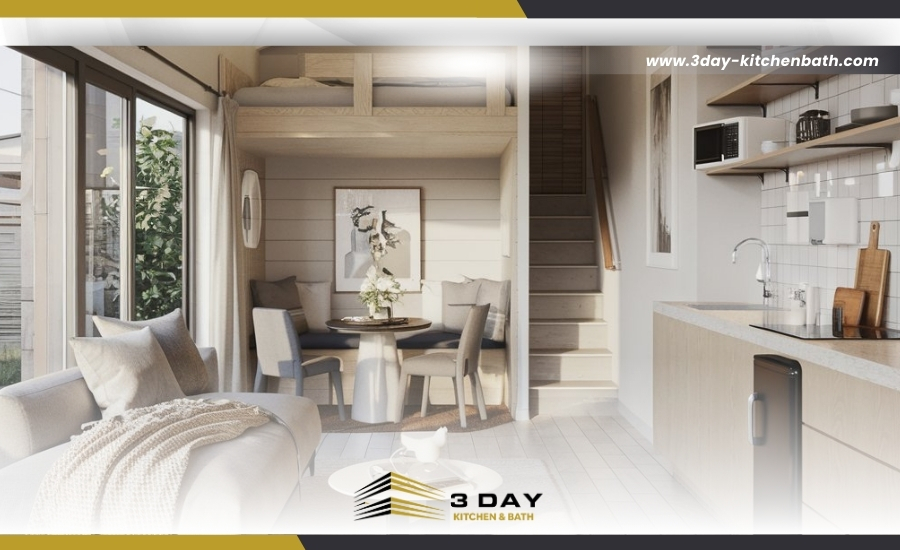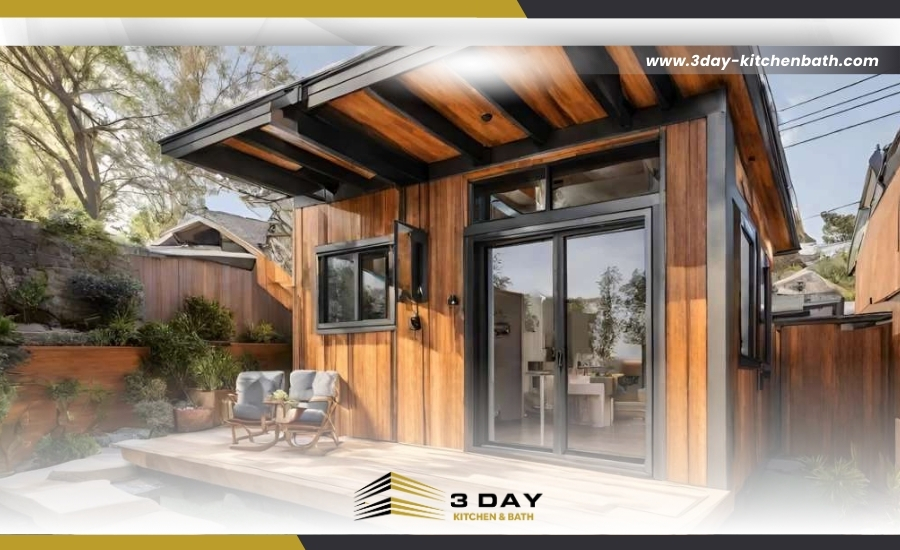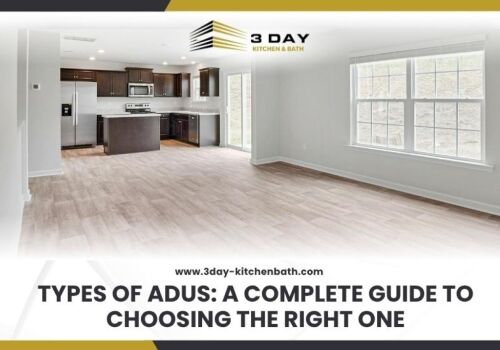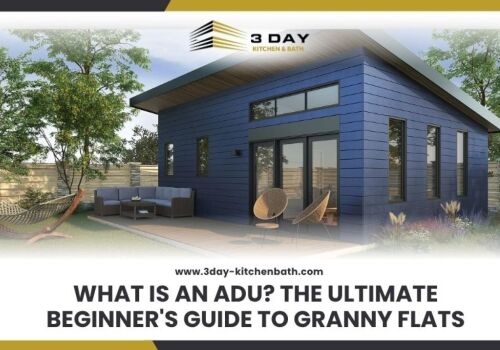- What Is an ADU Garage Conversion
- How a Garage ADU Differs from Other ADU Types
- Common Uses for a Garage ADU
- Benefits of Converting a Garage Into an ADU
- How a Garage ADU Maximizes Space
- Why Garage ADUs Increase Property Value
- Zoning Laws and Permits for a Garage ADU
- How to Check Local ADU Laws
- Step-by-Step Permit Process for a Garage ADU
- Risks of an Unpermitted Garage Conversion
- Best Design and Layout Ideas for a Garage ADU
- Space-Saving Layouts for a Garage ADU
- Smart Storage and Multi-Purpose Furniture
- How to Improve Lighting and Ventilation in a Garage ADU
- Add Space and Value to Your Property With a Garage ADU
- Frequently Asked Questions
- How long does it take to convert a garage into an ADU?
- Can you convert a detached garage into an ADU?
- What are the fire safety requirements for a garage ADU?
- Do you need to upgrade plumbing for a garage ADU?
- What are the best flooring options for a garage ADU?
- Start Your Garage ADU Conversion Today
An ADU garage conversion is one of the most practical ways to create additional living space while increasing property value. Homeowners looking to maximize their existing space without building a completely new structure often choose to convert their garages into an accessory dwelling unit (ADU).
Whether for rental income, multi-generational housing, or a private workspace, a garage conversion ADU can provide a fully functional living area with a separate entrance, kitchen, and bathroom. However, before starting, it’s important to understand zoning laws, design considerations, permits, and common uses to ensure a successful and legal conversion.
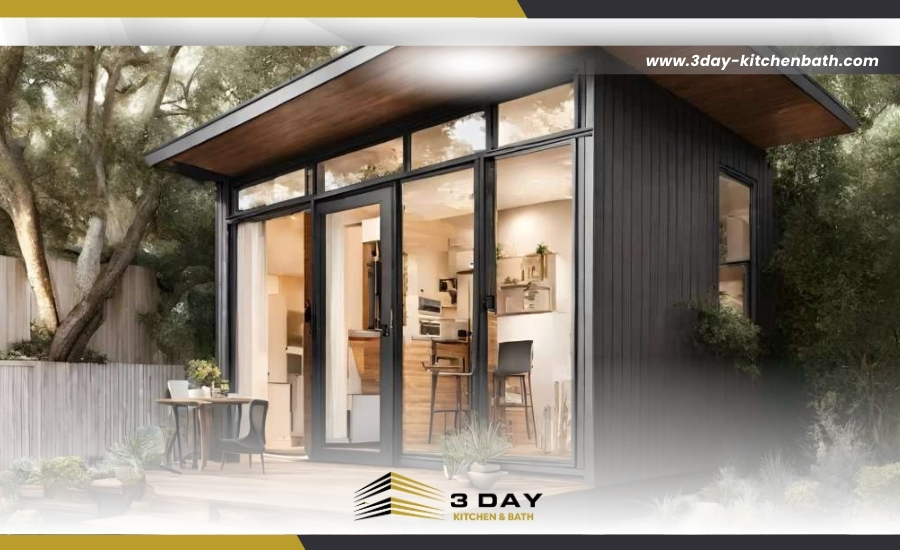
What Is an ADU Garage Conversion
A garage conversion ADU transforms an existing garage into a self-contained living unit with essential features like a kitchen, bathroom, and sleeping area. Garage ADUs use the existing structure, making them a cheaper way to add living space than building a new unit.
Many cities, including California, Texas, and Florida, allow garage ADU conversions under specific zoning laws. Still, compliance with building codes, permits, and parking requirements is necessary to avoid legal issues.
How a Garage ADU Differs from Other ADU Types
A garage ADU conversion is just one of several ways to add an accessory dwelling unit to a property. Homeowners should understand the differences before deciding if a garage ADU is the best choice for their needs:
- Garage ADU vs. Detached ADU: A detached ADU is a completely separate unit built elsewhere on the property, while a garage ADU uses the existing structure of an enclosed or detached garage.
- Garage ADU vs. Attached ADU: An attached ADU shares a wall with the main house but has a separate entrance. A garage ADU may also be attached but is converted from an existing garage.
- Garage ADU vs. Basement ADU: A basement ADU requires excavation and waterproofing, while a garage ADU often involves fewer structural modifications, making it a faster and cheaper option.
Common Uses for a Garage ADU
A garage conversion ADU offers flexibility and multiple uses, making it an appealing option for many homeowners. Some of the most common ways people use a garage ADU include:
- Rental Unit for Passive Income: A garage ADU can be leased as a long-term rental or short-term Airbnb, generating consistent monthly income.
- Guest House for Family and Friends: Converting a garage into a guest house provides a private living space for visitors or extended family.
- Home Office or Studio: A garage ADU can be customized into a quiet workspace for remote work or a creative studio for business owners.
- Housing for Adult Children or Aging Parents: Many homeowners use a garage ADU to provide affordable independent living for adult children or elderly parents.
Benefits of Converting a Garage Into an ADU
Converting a garage into an ADU offers several advantages for homeowners looking to increase their property's functionality and value. Unlike building a new structure, a garage ADU repurposes an existing space, making it a cost-effective and efficient solution.
Whether for rental income, guest housing, or personal use, a garage ADU provides flexibility without requiring additional land or major structural modifications.
How a Garage ADU Maximizes Space
A garage ADU uses an underutilized structure, allowing homeowners to create additional living space without altering the main house. This is especially beneficial for properties with limited lot size or zoning restrictions. Key advantages include:
- Preserve Yard Space: A garage conversion does not take up extra land, making it ideal for small lots or homes with limited outdoor areas.
- Avoids Major Construction: Since the garage structure already exists, homeowners can bypass the need for extensive foundation work and framing.
- Allows for Multi-Purpose Use: A garage ADU can be designed for multiple purposes, such as a rental unit, home office, or guest suite.
- Faster Completion Time: Because the core structure is in place, garage ADU conversions typically take less time than building a detached unit.
Why Garage ADUs Increase Property Value
A garage conversion ADU can significantly raise a property's resale value by adding functional square footage and increasing its appeal to potential buyers. Many homeowners see a strong return on investment due to the growing demand for ADUs in competitive housing markets. The primary ways a garage ADU adds value include:
- Boosts Square Footage: Converting a garage into a livable space increases the total usable area, making the home more attractive to buyers.
- Attracts a Wider Market: Homes with ADUs appeal to buyers looking for rental income opportunities or multi-generational living options.
- Provides an Additional Income Stream: Properties with a garage ADU can generate passive rental income, increasing their overall marketability.
- Increases Long-Term Appreciation: As cities encourage ADU development to address housing shortages, properties with ADUs continue to grow in demand and value.
Zoning Laws and Permits for a Garage ADU
Before converting a garage into an ADU, homeowners must understand local zoning laws and permit requirements. Each city and state has specific regulations regarding ADU conversions, including size, height, parking, and occupancy restrictions. Failing to comply with zoning laws can lead to costly fines, legal issues, or even the requirement to remove the conversion.
How to Check Local ADU Laws
Zoning laws vary by location, and homeowners must verify whether their property qualifies for a garage ADU. The key factors to review include:
- Minimum Lot Size Requirements: Some cities require a minimum lot size before allowing an ADU conversion.
- Setback Rules: Regulations dictate how far the ADU must be from property lines, fences, or other structures.
- Height Restrictions: Some areas limit the maximum height of an ADU, especially for two-story garage conversions.
- Parking Requirements: Some cities require homeowners to provide off-street parking if they convert a garage into an ADU.
- Owner-Occupancy Rules: Certain jurisdictions mandate that the property owner live on-site if renting out the ADU.
Step-by-Step Permit Process for a Garage ADU
Homeowners must follow a structured approval process before constructing a garage ADU. The required steps include:
- Consult the Local Planning Office: Visit the city’s building department or planning office to confirm ADU eligibility and requirements.
- Prepare a Site Plan and Architectural Drawings: Submit detailed blueprints that show the proposed layout, plumbing, electrical work, and structural changes.
- Apply for Building Permits: File the necessary permits, including zoning permits, building permits, electrical permits, and plumbing permits.
- Schedule Inspections: Inspectors will verify compliance with local building codes and safety regulations throughout construction.
- Obtain Final Approval: Once the ADU passes all inspections, the city issues a certificate of occupancy, allowing the unit to be legally used as a residence.
Risks of an Unpermitted Garage Conversion
Converting a garage into an ADU without proper permits can have serious legal and financial consequences. Homeowners who bypass the permitting process may face:
- Fines and Penalties: Cities impose heavy fines on unpermitted ADUs, which can increase daily until compliance is met.
- Risk of Demolition Orders: In severe cases, local authorities may require the illegal conversion to be reversed at the homeowner’s expense.
- Difficulty Selling the Property: Homes with unpermitted ADUs often fail inspections, making it challenging to sell or refinance.
- Safety Hazards: Without inspections, unpermitted ADUs may have faulty wiring, inadequate ventilation, or structural weaknesses that pose risks to occupants.
- Higher Insurance Costs or Claim Denials: Homeowners' insurance may refuse to cover damages related to an unpermitted ADU, leading to out-of-pocket expenses in case of an accident.
Best Design and Layout Ideas for a Garage ADU
A well-designed garage ADU should maximize space, enhance functionality, and provide a comfortable living environment. Since garages are often compact, thoughtful planning is essential to ensure efficient use of every square foot. Key considerations include open floor plans, smart storage solutions, and proper lighting and ventilation to create a livable space that meets building codes and personal needs.
Space-Saving Layouts for a Garage ADU
Optimizing the floor plan is crucial when converting a garage into an ADU. Depending on the size of the garage, homeowners can choose different layout configurations to make the most of the available space:
- Studio Layout: Ideal for single-car garages, a studio ADU combines the living, sleeping, and kitchen areas into a single open space with a small, separate bathroom.
- One-Bedroom Layout: Works well for two-car garages, offering a dedicated bedroom, a separate living space, and a compact kitchen.
- Two-Bedroom Layout: Suitable for larger garages, allowing for a fully functional living space with a private bedroom, guest room, or office.
- L-Shaped or U-Shaped Kitchen: Maximizes counter space while keeping the layout compact and efficient.
- Loft Sleeping Area: If ceiling height allows, a loft bed frees up space for additional living or storage areas.
Smart Storage and Multi-Purpose Furniture
Since garage ADUs often have limited square footage, storage must be integrated into the design without cramming the space. Effective storage solutions include:
- Built-In Cabinets and Wall Shelving: Maximizes vertical space for storage without taking up floor area.
- Murphy Beds and Foldable Furniture: Beds that fold into the wall or sofas that convert into beds allow flexible room usage.
- Under-Stair Storage: If the ADU has a loft or split-level design, the space beneath the stairs can be used for extra storage.
- Hidden Storage Compartments: Built-in storage in seating areas, under beds, or in kitchen islands keeps clutter out of sight.
- Sliding or Pocket Doors: Saves space compared to traditional swinging doors, making rooms feel more open.
How to Improve Lighting and Ventilation in a Garage ADU
Garages typically lack natural light and proper airflow, making lighting and ventilation upgrades essential for a comfortable living space. Ways to enhance these features include:
- Adding Windows and Skylights: Increases natural light and reduces the need for artificial lighting during the day.
- Installing Glass Doors: Replacing the garage door with sliding glass doors or French doors improves brightness and outdoor connectivity.
- Using Light Colors and Reflective Surfaces: Lighter paint colors, mirrors, and glossy finishes help make small ADUs feel more spacious.
- Upgrading HVAC and Ventilation Systems: Proper heating, cooling, and ventilation systems are needed to maintain air quality and regulate temperature.
- Ceiling Fans and Exhaust Vents: Help circulate air and prevent moisture buildup in bathrooms and kitchens.
Add Space and Value to Your Property With a Garage ADU
Converting a garage into an ADU in San Diego provides homeowners a versatile and high-value addition. A well-designed ADU garage conversion offers rental income, multi-generational living options, and increased property value without requiring major new construction. With rising housing demands, an ADU provides an affordable housing solution while maximizing the use of existing space.
At 3 Day Kitchen & Bath, we specialize in garage ADU conversions, ensuring that every project meets local zoning laws, safety codes, and high-quality design standards. Whether you need a rental unit, guest suite, or home office, our expert team helps you create a functional, compliant, and beautifully designed ADU that fits your needs.
Frequently Asked Questions
How long does it take to convert a garage into an ADU?
The timeline for a garage ADU conversion depends on permitting, design complexity, and construction. The process takes three to six months from planning to completion. Permit approval can take a few weeks to several months, depending on local San Diego, CA regulations. Once construction begins, framing, electrical, plumbing, and finishing work typically take two to four months. Hiring experienced ADU contractors like 3 Day Kitchen & Bath can help streamline the process and prevent unnecessary delays.
Can you convert a detached garage into an ADU?
Yes, a detached garage ADU is possible, but it must meet zoning and setback requirements. Unlike attached ADUs, detached garage conversions often require additional structural reinforcement, independent utility connections, and separate entrances. Some cities may have stricter regulations for detached ADUs, such as height limits and distance from the main home. It’s important to check with local planning offices in San Diego to ensure compliance before beginning the project.
What are the fire safety requirements for a garage ADU?
Fire safety is a key concern for garage ADUs, and compliance with local building codes is mandatory. Fire safety measures include smoke detectors, carbon monoxide alarms, fire-rated walls, and proper ventilation. If the ADU shares a wall with the main house, fire-resistant materials may be required. Additionally, some cities require fire sprinklers based on square footage and occupancy. Always consult with professionals to ensure the ADU meets the latest fire protection standards.
Do you need to upgrade plumbing for a garage ADU?
Yes, a garage ADU conversion typically requires plumbing upgrades to accommodate new kitchens, bathrooms, and laundry areas. In most cases, the existing garage plumbing is minimal or nonexistent, so homeowners must install new water supply lines, drainage systems, and sewer connections. Upgrading the plumbing must comply with local building codes, and a licensed plumber should handle the installation to ensure proper flow, pressure, and drainage.
What are the best flooring options for a garage ADU?
The best flooring for a garage ADU depends on durability, moisture resistance, and comfort. Popular options include waterproof vinyl plank flooring, low-maintenance and engineered hardwood, which provides a high-end look with better moisture resistance than traditional hardwood. Tile flooring is ideal for bathrooms and kitchens, while sealed concrete offers a modern, industrial style with minimal upkeep. Flooring should include insulation and underlayment to prevent cold or uneven surfaces.
Start Your Garage ADU Conversion Today
A garage ADU conversion can transform your property into a functional and profitable space. With the right permits, design, and expert guidance, your new ADU can be completed in just a few months. Call 3 Day Kitchen & Bath at (619) 604-9103 to schedule a consultation and start your garage ADU project in San Diego today.

